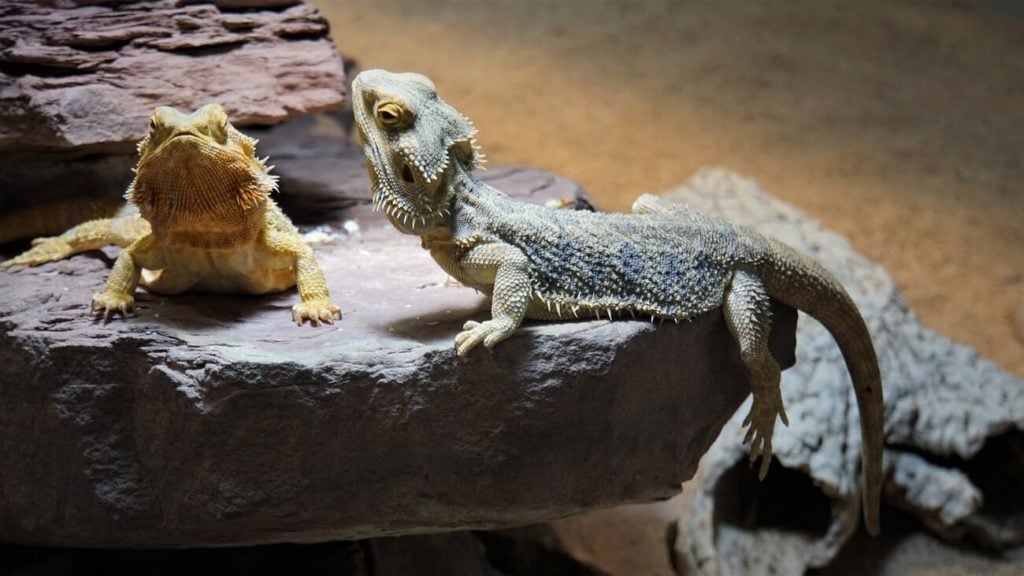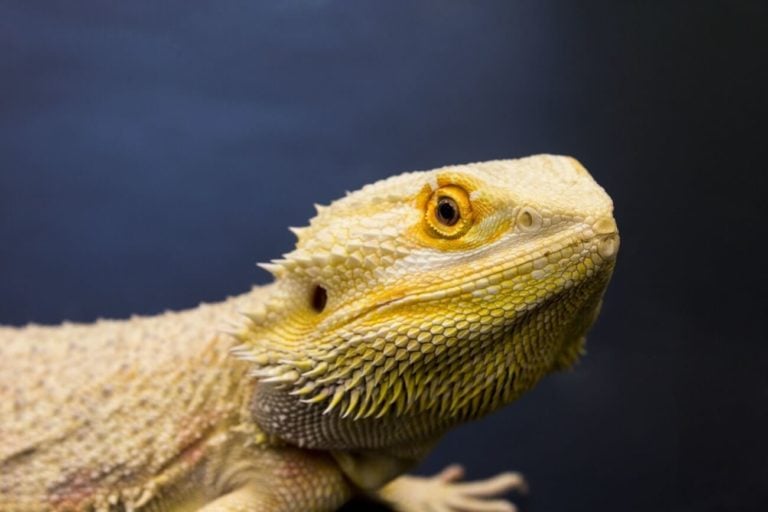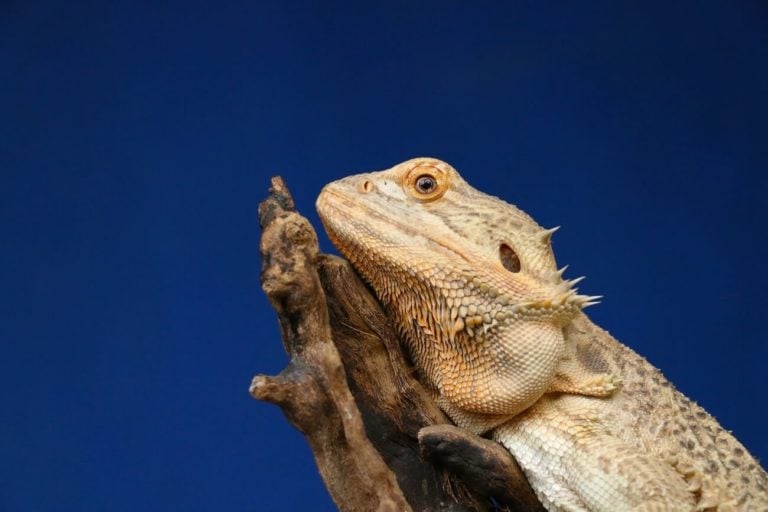Figuring out how to sex a bearded dragon is crucial for pretty much all owners. Knowing what gender you have can make it easier to provide top-notch care, or consider breeding them in the future.
But doing this is trickier than it seems. Unlike many other animals, there aren’t obvious external signs to tell the difference between males and females.
And that’s where this guide comes in. We’ll teach you how to sex a bearded dragon using a number of different and efficient methods.
Table of Contents
Methods For Sexing Bearded Dragons
There are a number of methods that will help bearded dragon owners figure out the gender of their pet lizard.
However, it’s worth pointing out that trying to sex a bearded dragon when it’s younger than 4 weeks is pretty much impossible. At best, gender determinations when they’re younger than this are simply educated guesses at best.
In general, it is easiest to determine whether a bearded dragon is male or female after they have reached 4 to 6 months of age. However, some experienced owners and breeders can make fairly accurate gender determinations over 4 weeks of age to 12 weeks.
When it comes to sexing bearded dragons there are a few different tactics you can use. These gender determination methods include:
- Hemipenal Bulges
- Femoral Pore Size
- Behavior
- Size & Shape Differences
Identify The Hemipenal Bulges
One of the most effective and popular ways to determine whether your precious beardie is a female or male is to identify the hemipenal bulges.
Expert Tip: To use this method you’ll need to wait until the reptile is over 4 to 8 weeks old. However, if you don’t have a lot of experience this method will get significantly easier once they’ve reached 4 to 6 months of age.
Male bearded dragons will have two hemipenal bulges that can be felt underneath the tail near to their anus. To put it more simply, there will be one bulge on either side on the underside of the tail.
In contrast, a female bearded dragon will only have one hemipenal bulge (or bumps) located centrally on the underside of the tail near to the anus.
When checking this it’s important to hold your beardie gently. Make sure that you support the their tail and legs to help prevent injury to your pet.
Gently lift the tail and look at the underside of the tail. Do not perform this move quickly or too aggressively. Otherwise, your bearded dragon might experience pain and even injury.
It can be difficult to spot the bulges at first. Start slowly and gradually increase tail height to help smooth out the tail skin on the underside enough to properly see the bumps.
If you’re still unable to spot the bulges, your dragon might simply be too young. Your beardie might be a bit overweight as well, making visual inspection more difficult.
Fortunately, there’s a variation of this method that can make everything a whole lot easier…
Use A Flashlight
To perform the flashlight method for sexing bearded dragons, hold your pet in the same way we described in the section above. Ensure that its tail and legs are supported properly before gently lifting up the tail to look on the underside tail area at the same location.
And this is where things get kind of neat.
With this method, you’ll be using a flashlight to assist visual inspection! The light will help make the bulges easier to spot through the tail.
- Mini penlight gives out max 150 lumens
- Small and light enough to slip into a pocket
- Effective battery light with multiple hours of continuous use
- Comes with 100% satisfaction guarantee
Expert Tip: Turn off all or most of the surrounding lights in the room to make spotting the bulges easier.
Holding your dragon pet ever so gently, slowly ease the tail upwards being careful not to exert too much pressure. Your dragon may react angrily or become aggressive if it feels discomfort (in rare instances this can result in a bite).
Shine the flashlight beam downwards on the top of the tail right at the junction where the tail is connected to the dragon’s body. Holding the light in place, look closely at the underside of the tail.
You should be able to see the light shining through the tail, highlighting the dark bulges! As we mentioned earlier, two of these hemipenal bulges on either side of the tail indicates that your bearded dragon is a male, and one hemipenal bulge situated in the central portion of the tail underside indicates a female.
These bulges will look like shadows. This is because they block the light from the flashlight creating natural shadows where the bump is present. Here’s a video that shows this method in action.
Inspect The Femoral Pores
Another method to determine whether the sex of your bearded dragon is male or female is to look for the characteristics and differences of the femoral pores. These femoral pores are located on the bottom area of your pet’s hind legs.
Expert Tip: These femoral pores are the area where the lizard secretes pheromones. The pheromones are chemicals that bearded dragons use to communicate to others that are nearby.
The femoral pores are used during their mating seasons. The mating period begins around one month following brumation. Brumation is somewhat similar to other animal’s hibernation periods. The dragon slows down and sleeps longer during this time frame.
Bearded dragons begin to secrete the pheromones in order to indicate that they are ready to mate. Other nearby dragons of the opposite sex will respond to these secretions.
It should be noted that both the female dragon and the male have these femoral pores. However, they look a bit different, and this is what should be looked for when trying to establish the sex gender of your small pet dragon.
Look for spots that are located from knee to knee on your dragon’s underside of its hind legs.
Males will have femoral pores(or spots) that are more pronounced in color. These spots are larger as well. Females then have smaller sized femoral pores, and the color of the spots appear more faded.
Pay Attention To Their Behavior
Carefully watching your bearded dragon’s behavior can give you a clue to indicate whether they are male or female. While this method definitely isn’t perfect, it can give you an idea.
But first, you need to know which behaviors are common among bearded dragons in general. The main ones are:
- Arm Waving
- Puffed Black Head
- Head Bobbing
- Hissing
Arm Waving
Bearded dragons may use waving behavior to signify submission before a larger or more aggressive male. It is also an indicator that a female is ready to mate.
Additionally, this behavior is used by beardies when other aggressive or predators are located nearby. The waving is performed as a warning to other bearded dragons that are in the same vicinity.
Sometimes, this can be used in combination with certain color changes to act as a warning sign of danger.
Puffed Black Beard
Bearded dragons will exhibit a puffed head area when confronted by another beardie or some nearby danger. Their beard may turn black in hue as well.
This behavior likely indicates that the reptile is experiencing some kind of stress and is an attempt to show its dominance over the nearby threat. It’s also a signal that the bearded dragon is ready to fight and defend itself or its perceived territory.
In general, this behavior is something you’ll see in males more than females.
Head Bobbing
When a beardie begins to head bob, it is trying to show both aggression and submission (a confusing combo). It’s more likely to indicate aggression when done in tandem with other aggressive behavior.
Head bobbing that occurs with submissive behavior like waving will typically indicate a more submissive behavior stance.
This head-bobbing may also be used when the bearded dragon is ready to mate. It is typically seen more often with male bearded dragons in this situation.
Hissing
Hissing is a less common behavior, but it can still be used when sexing bearded dragons. It usually occurs when a male dragon is threatened by a larger-sized predator or another dragon that enters its territory.
While this isn’t something you’ll likely see from a beardie in captivity, there’s a strong chance you have a male if it does occur.
Are There Any Size Or Shape Differences Between Males And Females?
While there are some high-level differences between each gender, using this as your primary method of sexing bearded dragons is unreliable. Instead, we recommend using it as another piece of information if you’re still unsure after using the methods listed above.

Male bearded dragons generally have a thicker and larger head. They’re also more likely to puff out and blacken the color of their beard. Spikes may become more visible during mating as well.
In addition to this, males usually have a thicker tail from tip to end. This is more apparent as they get older though.
Females, on the other hand, have a more trim and overall smaller head size. They also have a noticeably thinner tail.
When Are They Old Enough For You To Determine Their Gender?
While we provided the general rule earlier in the guide, there are a few additional details that we wanted to include.
Determining the sex of a bearded dragon can be difficult when the lizard is under 4 to 6 months of age (if you don’t have a lot of experience). However, expert owners and breeders with many years of experience under their belt can usually determine the gender much earlier.
It’s not uncommon for an experienced breeder to accurately sex bearded dragons at the 8 to 12-week mark! Some reptile specialists may even determine the gender when the beardie is as young as 4 weeks old.
An interesting fact is that knowing the age of your bearded dragon can actually make it a lot easier to tell what sex you’re dealing with.
Owners of pet bearded dragons can usually get the age record of their pet from the breeder that sold the beardie to them in the first place. Reputable breeders will keep accurate records of the birth, growth, and age of their bred reptiles.
If the pet owner does not have access to the breeder’s records, there are age charts that can be referenced that can use the size of your bearded dragon to come up with an approximate age.
When measuring your bearded dragon to determine their approximate age, be sure to include the tail in this measurement. Take your ruler or tape measure and measure from the dragon’s head all the way to the tip of the tail.
Expert Tip: Remember that most charts are going to be useful for the most common species of dragons. There are other smaller species of this reptile that are rare and tend to be much smaller than the common pet varieties.
Conclusion
As you can see, learning how to sex a bearded dragon is a lot easier than it seems. Once you know the correct methods, it’s actually rather straightforward!
As long as you stick to the recommendations in this guide and handle your beardie carefully, we have complete confidence that you’ll be able to safely figure out their gender.




